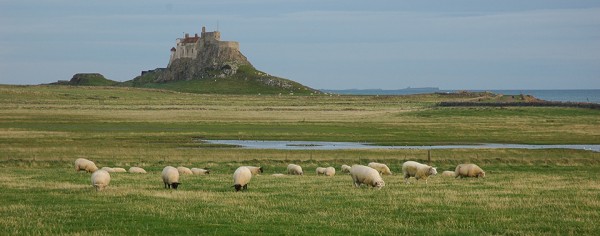
The Sacred Natural Site Initiative regularly features “Conservation Experiences” of custodians, protected area managers, scientists and other’s. This time we are featuring the experience of Mr. Robert Wild who has developed a case study on Lindisfarne Holy Island as part of the Delos Initiative. Robert is a social scientist, ecologist and also coordinator for the Sacred Natural Sites Initiative who takes a keen interest in supporting local peoples’ efforts to govern and celebrate the places that are dear to them. This case study is also featured in the books; “Sacred Natural Sites; Conserving Nature and Culture” as well as “The Diversity of Sacred Lands in Europe“. Also read the full case study.
The Holy Island of Lindisfarne and its surrounding marine wetlands is an important area for coastal habitats and wintering wildfowl. It has been a Christian holy site and pilgrimage centre since AD 635 when it served a pivotal role as a “cradle” of Christianity in northern Britain. One of its leading saints St Cuthbert was considered as one of England’s first ‘nature conservationists’ and he is still the most recognised saint in the area.

The Holy Island of Lindisfarne has been a Christian holy site and pilgrimage centre since AD 635 when it served a pivotal role as a “cradle” of Christianity in northern Britain. Photo: Robert Wild
Parts of the island and all the surrounding wetlands are a National Nature Reserve, while the island itself houses a village, historic buildings, several churches and retreat centres. In recent years, it has hosted an increasing number of visitors and pilgrims. The demands of visitors have the potential to cause an imbalance between the islands values including those of the local community heritage, ecology and economic.
The Holy island of Lindisfarne is managed by a wide range of institutions, all with the intention to conserve an aspect of the site, be it religious, natural or cultural. When asked the question ‘who is in charge of the Holy land?, the universal response is “no-one”. Even though a single structure to provide direction would be both inappropriate and ineffective, a greater collective sense of direction might be needed.
No clear mechanisms have been established to discuss or decide the trade-offs between different visions and development paths. The island is now dealing with these within the framework of national law. There is a growing awareness that separate institutions should aim at working together more. The 2005 Natural England vision for Lindisfarne National Natural Reserve put emphasis on a holistic and integrated approach. The Community Development Thrust is widening its remit and gaining in experience, and is therefore better able to represent the community with larger institutions on a more equal footing. Some community members can now reside locally at affordable costs, helping to keep the heart of the local culture intact.






